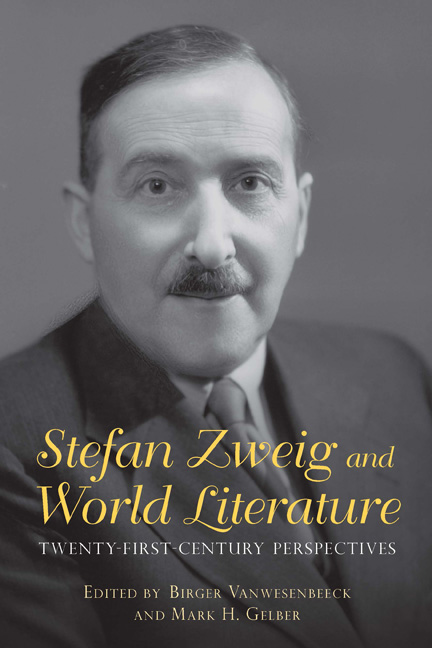Book contents
- Frontmatter
- Dedication
- Contents
- List of Illustrations
- Acknowledgments
- Introduction
- Part I Reception
- Part II Drama and Fiction
- Stefan Zweig's Drama Jeremias in Context
- 3 “That Voice in the Darkness!”: Technologies of the Tropical Talking Cure in Stefan Zweig's Der Amokläufer and Verwirrung der Gefühle
- 4 Narrating Alterity: Stefan Zweig, Emmanuel Levinas, and the Trauma of Redemption
- Part III Criticism and Essays
- Part IV Politics and Exile
- Notes on the Contributors
- Index
3 - “That Voice in the Darkness!”: Technologies of the Tropical Talking Cure in Stefan Zweig's Der Amokläufer and Verwirrung der Gefühle
from Part II - Drama and Fiction
Published online by Cambridge University Press: 05 May 2015
- Frontmatter
- Dedication
- Contents
- List of Illustrations
- Acknowledgments
- Introduction
- Part I Reception
- Part II Drama and Fiction
- Stefan Zweig's Drama Jeremias in Context
- 3 “That Voice in the Darkness!”: Technologies of the Tropical Talking Cure in Stefan Zweig's Der Amokläufer and Verwirrung der Gefühle
- 4 Narrating Alterity: Stefan Zweig, Emmanuel Levinas, and the Trauma of Redemption
- Part III Criticism and Essays
- Part IV Politics and Exile
- Notes on the Contributors
- Index
Summary
The following reading of stefan zweig's novellas Der Amokläufer (“Amok,” 1922) and Verwirrung der Gefühle (“Confusion,” 1927) attempts to tackle a question related to the intermedial dynamics of modernism. The decades between the early 1880s and the late 1920s saw the appearance of numerous literary texts dealing with—and at times obsessing over—new sound recording and storage devices such as the phonograph and the gramophone. There are lesser-known texts by well-known authors (Arthur Conan Doyle's non-Sherlock Holmes stories “The Voice of Science” and “The Japanned Box,” or Jules Verne's truly McLuhanesque media novel The Carpathian Castle); there are famous texts by authors whose other writings have been forgotten (most notably, Bram Stoker's Dracula); and there are famous texts by authors whose fame dwarfs even that of Zweig (think, for instance, of the gramophone séances in Thomas Mann's The Magic Mountain). To be sure, the literary engagement with the impact of a given media technology does not require that the technology itself be clearly depicted in the text. The artifact may be distorted almost beyond recognition, as in the case of the lethal(ly) legal apparatus in Franz Kafka's “In der Strafkolonie” (In the Penal Colony, 1919) which some say is modeled on a phonograph. Or it may be completely absent, as in Joseph Conrad's Heart of Darkness. There are no phonographs in Conrad's tale, and yet it depicts a plethora of phonographic tropes related to the cultural and epistemological problems posed by mechanical sound reproduction: from the horror over the disembodied voice and an awareness of far-reaching changes in the relationship between background noise and foreground message, to the dreaded suspicion that the ability to sever voice and language from body and mind has revealed that we did not have any control over our language in the first place. As we shall see, much of this applies to Zweig's Der Amokläufer.
- Type
- Chapter
- Information
- Stefan Zweig and World LiteratureTwenty-First Century Perspectives, pp. 56 - 73Publisher: Boydell & BrewerPrint publication year: 2014
- 1
- Cited by



